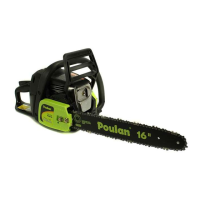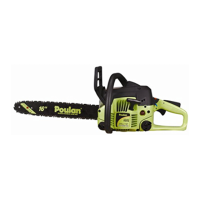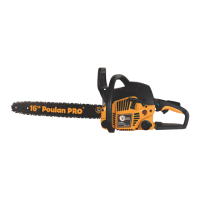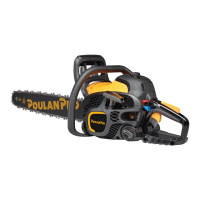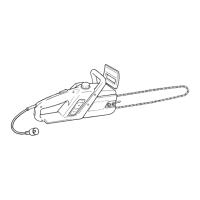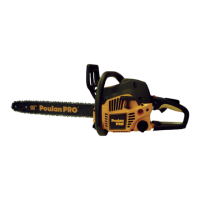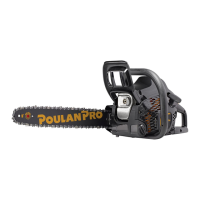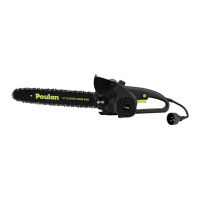.
The
wind direction and speed.
.
The
lean of the tree.
The lean of a tree
might not be apparent due to uneven or
sloping terrain. Use a
plumb
or
level to de-
termine the direction of tree
lean.
.
Weight and branches on one side.
.
Surroundrng trees
and obstacles.
Look
for
decay and
rot. lf the trunk is rotted,
it
can snap and fall toward the operator.
Check
for
broken or dead branches
which
can fall on
you
while cutling.
Make sure there is enough
room for
the
tree to
fall.
Maintain
a dislance of
2 1i2 tree lengths
from the nearest
person
or other objects. En
grne
noise can drown out a warning call.
Remove
dirt. slones.
loose bark. nai1s, sta'
ples,
and wire
from
the tree
where
cuts
are to
be made. Plan a clear retreat
path
to the
rear
and diagonal
to the iine of fal1.
\".-
Plan
a clear
retreat
path
\'-o-
\.
^n'
?
-{
}
+
Drrurlru,ri
fa,
\r'
./:z>\
/sc
FELLING LARGE TREES
(6
inches
(15
cfir) in diameter or
larqer)
The nolr h nelhod is used lo [e]l
larqe
t'eos
A notch is cut on the side of the tree
rn
the de-
sired direction of fall. After a
felling
cut
is
made on the opposite side of tree,
the tree
wrll tend to fall rnto the notch.
NOTE: lf
the
tree has larqe
buttress
roots.
remove them before making the notch.
l1
us-
ing
saw to
rernove
bultress
roots. keep
saw
chain from contacting
ground
to
prevenl
dLrll'
inq
ol
the
charn.
NOTCH CUT
AND FELLING THE
TREE
.
Make notch cut by cutting the
top
of
the
notch frrst. Cut through
1
'3
of the diameter
oJ the tree. Next complete the
notch
by cut
ting the bottonr of the
notch.
See
illustra
tion. Once the
notch is
cllt
remove the
nolch
of
wood from lhe lree
Final
(felling)
cut
here, 2 inches
(5
cm) above center of
notch.
A{ter removing
the
wood irom the notch.
make
the
{ellrng
cut on the opposite side of
the notch. This is done by making a cut about
two inches
(5
cm) higher than the center of
the notch.
This
will
leave
enough uncut
wood
between the
fellino
cut and the
notch to form
a
hinge. This hingie will help
prevent
the lree
from falling
in
the wrong direction.
Hinge holds tree
on stump and
helps
control
fall
NOTE: Before felling cut is complete. use
^edges
lo
open
the
cut
if necessary lo
controlthed/rectionof fall. To avoid
kickback
and charn damage, use wood or
plastic
wedges, but
never
steel or
iron wedges.
.
Be alert
to
signs that the lreq
is ready to
fall: cracking sounds. wrdening of the
fell
ing cut, or movement in the upper
orancnes.
.
As
tree slarls
lo ldll.
slop saw.
pul
ildown.
and
get
away
quickly
on
your
planned
re-
treat
path
.
DO NOT cLrt down a
partially
fallen
tree
with
your
saw. Be extrerrely cautious
with
partially
fallen trees that may be
poorly
supported. When a tree doesnt
fall
com
plelely.
sel
lhe
s.rw aside and
p.rlldown
lhtr
tree with a cabie winch, block and tackle.
or Iraclor
CUTTING
A FALLEN TREE
(BUCKTNG)
Bucking is the ter| used for
cutting
a fallen
tree to the oesrred
log
srze.
A
wnnrutruc: Do nor srand on the
tog
being cut.
Ar)y
portlon
can
roll
causing
loss
of footing and control. Do not
stand
downhrll
of
the log
berf
g
cut
IMPORTANT POINTS
.
Cut
on
y
one log at
a
time.
.
Cut shatlered wood very carefully, sharp
preces
of
wood
could be flung toward opera
tor.
.
Use a sawhorse to cut small
logs. Never
a
low another
person
to hold the
log whrle
cutting
and never hol.l the oq w th
your
cq
or
foot
.
Do not cut n an area vr'here ogs.
lrmbs.
dld'ool'
drP
ldrqlod
-.
r I
t:
n
a blown
down area Drag the
logs nto
a clear area
before cutt ng by
pul
Ing
out exposed and
cleared
logs f rst
TYPES
OF CUTTING USED
FOR
BUCKING
Awnnrutruc:
rf saw becomes
pinched
or
hung rn a log,
dont
try to
force
it
out. You can
losecontrol
ofthe sawresulting
in inlury andi or damage to the saw. Stop
the
saw, drive a
wedge
of
plastic
or
wood
into
the
cul
until the saw
can
be removed easily.
Re-
tz
t

